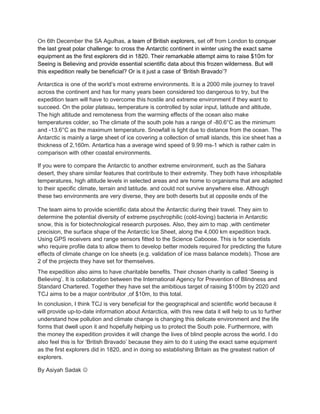
Asiyah geog assesment
- 1. On 6th December the SA Agulhas, a team of British explorers, set off from London to conquer the last great polar challenge: to cross the Antarctic continent in winter using the exact same equipment as the first explorers did in 1820. Their remarkable attempt aims to raise $10m for Seeing is Believing and provide essential scientific data about this frozen wilderness. But will this expedition really be beneficial? Or is it just a case of ‘British Bravado’? Antarctica is one of the world’s most extreme environments. It is a 2000 mile journey to travel across the continent and has for many years been considered too dangerous to try, but the expedition team will have to overcome this hostile and extreme environment if they want to succeed. On the polar plateau, temperature is controlled by solar input, latitude and altitude, The high altitude and remoteness from the warming effects of the ocean also make temperatures colder, so The climate of the south pole has a range of -80.6°C as the minimum and -13.6°C as the maximum temperature. Snowfall is light due to distance from the ocean. The Antarctic is mainly a large sheet of ice covering a collection of small islands, this ice sheet has a thickness of 2,160m. Antartica has a average wind speed of 9.99 ms-1 which is rather calm in comparison with other coastal environments. If you were to compare the Antarctic to another extreme environment, such as the Sahara desert, they share similar features that contribute to their extremity. They both have inhospitable temperatures, high altitude levels in selected areas and are home to organisms that are adapted to their specific climate, terrain and latitude. and could not survive anywhere else. Although these two environments are very diverse, they are both deserts but at opposite ends of the The team aims to provide scientific data about the Antarctic during their travel. They aim to determine the potential diversity of extreme psychrophilic (cold-loving) bacteria in Antarctic snow, this is for biotechnological research purposes. Also, they aim to map ,with centimeter precision, the surface shape of the Antarctic Ice Sheet, along the 4,000 km expedition track. Using GPS receivers and range sensors fitted to the Science Caboose. This is for scientists who require profile data to allow them to develop better models required for predicting the future effects of climate change on Ice sheets (e.g. validation of ice mass balance models). Those are 2 of the projects they have set for themselves. The expedition also aims to have charitable benefits. Their chosen charity is called ‘Seeing is Believing’. It is collaboration between the International Agency for Prevention of Blindness and Standard Chartered. Together they have set the ambitious target of raising $100m by 2020 and TCJ aims to be a major contributor ,of $10m, to this total. In conclusion, I think TCJ is very beneficial for the geographical and scientific world because it will provide up-to-date information about Antarctica, with this new data it will help to us to further understand how pollution and climate change is changing this delicate environment and the life forms that dwell upon it and hopefully helping us to protect the South pole. Furthermore, with the money the expedition provides it will change the lives of blind people across the world. I do also feel this is for ‘British Bravado’ because they aim to do it using the exact same equipment as the first explorers did in 1820, and in doing so establishing Britain as the greatest nation of explorers. By Asiyah Sadak
